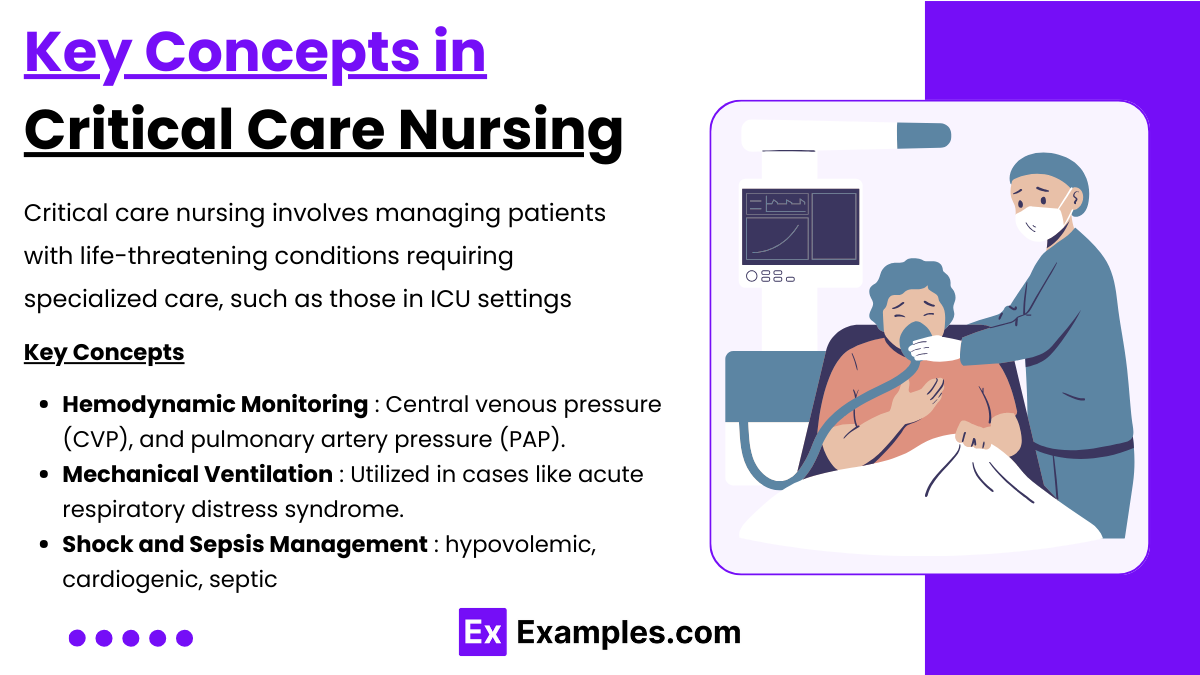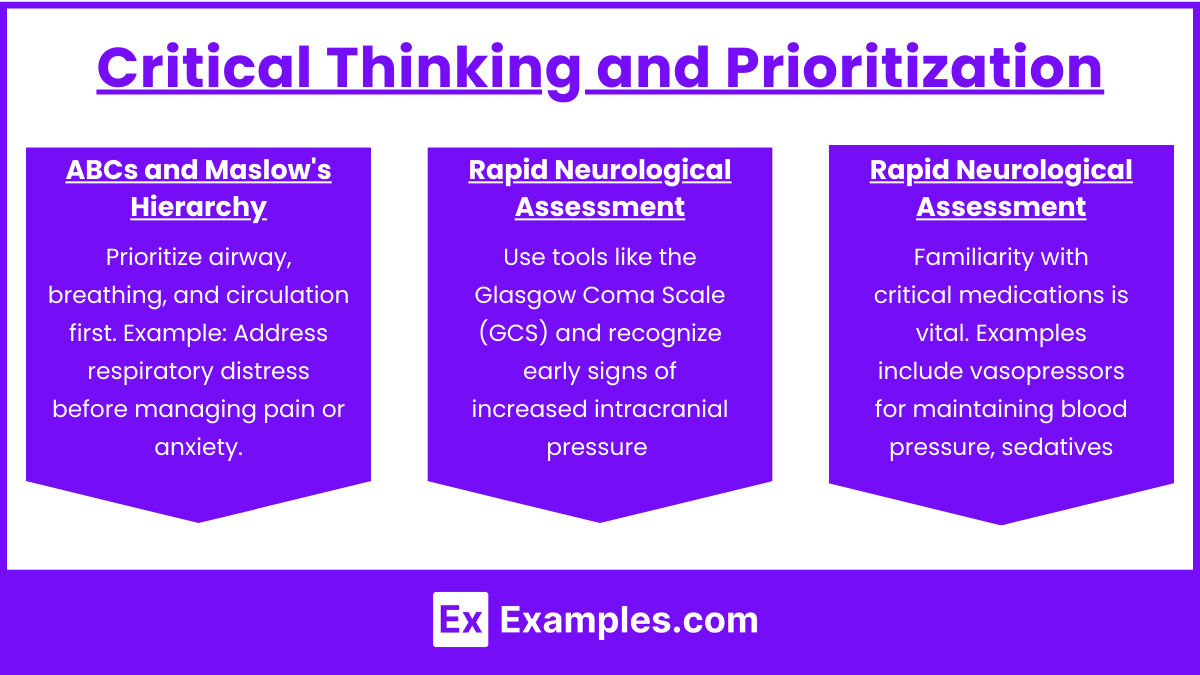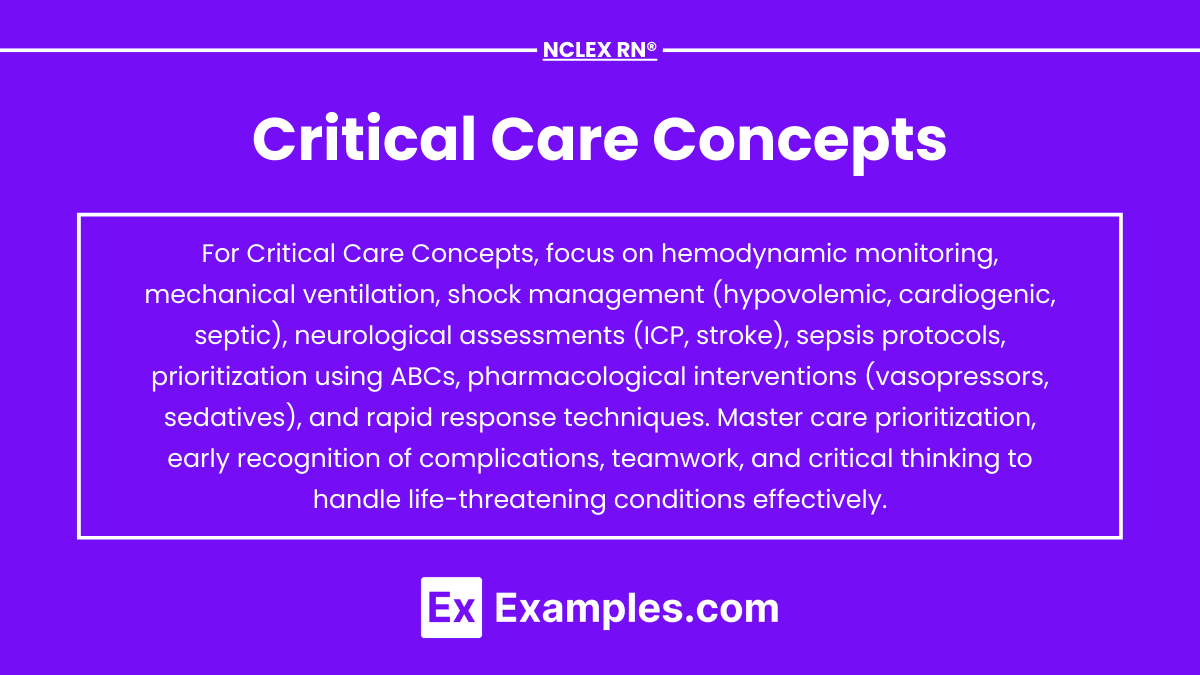Critical care concepts are essential in managing critically ill patients with life-threatening conditions requiring intensive monitoring and interventions. These concepts encompass advanced understanding of hemodynamic stability, mechanical ventilation, neurological assessments, and management of complex conditions like shock and sepsis. Nurses in critical care must prioritize using the ABCs (Airway, Breathing, Circulation), rapid decision-making, and clinical judgment. Mastery of these principles ensures effective responses to emergencies, enhances patient outcomes, and prepares nurses for the complexities of critical care scenarios, including those tested on the NCLEX-RN® exam.
Learning Objectives
In studying “Critical Care: Critical Care Concepts” for the NCLEX-RN® exam, you should learn to understand the principles of managing critically ill patients, including hemodynamic monitoring, mechanical ventilation, and shock management. Analyze the use of interventions such as vasoactive medications, fluid resuscitation, and infection control. Evaluate the significance of rapid assessments, neurological monitoring, and prioritization using the ABC framework. Additionally, explore the clinical application of these skills in stabilizing life-threatening conditions and preventing complications. Apply your understanding to interpreting clinical scenarios and prioritizing nursing interventions in NCLEX practice questions that reflect critical care situations.
1. Key Concepts in Critical Care Nursing

Critical care nursing involves managing patients with life-threatening conditions requiring specialized care, such as those in ICU settings. For the NCLEX-RN® exam, understanding critical care concepts is vital for assessing, prioritizing, and delivering interventions for critically ill patients. Key topics include hemodynamic monitoring, mechanical ventilation, acute organ failure, and sepsis management. Understanding critical care fundamentals is essential for excelling in the NCLEX-RN®.
Key Concepts:
- Hemodynamic Monitoring:
- Continuous evaluation of cardiovascular performance using parameters like cardiac output, central venous pressure (CVP), and pulmonary artery pressure (PAP). Devices such as arterial lines and Swan-Ganz catheters are commonly used.
- NCLEX Tip: Identify and intervene in conditions like hypotension or decreased cardiac output.
- Mechanical Ventilation:
- Utilized in cases like acute respiratory distress syndrome (ARDS) and respiratory failure. Familiarity with ventilation modes (e.g., Assist-Control Ventilation, SIMV) and complications like barotrauma or ventilator-associated pneumonia (VAP) is crucial.
- NCLEX Tip: Prioritize interventions to prevent VAP and monitor readiness for weaning.
- Shock and Sepsis Management:
- Recognizing and treating various types of shock (hypovolemic, cardiogenic, septic, neurogenic, and anaphylactic) and systemic inflammatory response syndrome (SIRS) is critical. Multisystem organ dysfunction syndrome (MODS) can result if interventions are delayed.
- NCLEX Tip: Emphasize early recognition and adherence to the ABCs (Airway, Breathing, Circulation).
2. Critical Thinking and Prioritization

The NCLEX-RN® often tests your ability to prioritize and apply clinical judgment. Key strategies include:
- ABCs and Maslow’s Hierarchy:
- Prioritize airway, breathing, and circulation first. Example: Address respiratory distress before managing pain or anxiety.
- Rapid Neurological Assessment:
- Use tools like the Glasgow Coma Scale (GCS) and recognize early signs of increased intracranial pressure (e.g., Cushing’s triad: bradycardia, hypertension, and irregular respirations).
- Pharmacological Interventions:
- Familiarity with critical medications is vital. Examples include vasopressors (e.g., norepinephrine) for maintaining blood pressure, sedatives (e.g., propofol), and paralytics (e.g., succinylcholine) for mechanical ventilation.
- NCLEX Tip: Understand drug actions, side effects, and contraindications.
3. Common Critical Care Conditions and Their Management

Understanding the management of specific conditions is critical for NCLEX-RN® success:
- Acute Respiratory Distress Syndrome (ARDS):
- Characterized by severe hypoxemia and respiratory failure. Managed with mechanical ventilation, prone positioning, and addressing underlying causes (e.g., sepsis or trauma).
- Cardiac Emergencies:
- Conditions such as myocardial infarction (MI) and heart failure require rapid interventions, including oxygen administration, nitroglycerin, and monitoring for complications like arrhythmias.
- Neurological Crises:
- Examples include stroke and traumatic brain injury. Early recognition of signs (e.g., unilateral weakness, altered consciousness) and swift interventions (e.g., thrombolytics for ischemic stroke) are vital.
- Sepsis and MODS:
- Early identification of sepsis through criteria like SIRS and lactate levels ensures timely management. Treatment involves fluid resuscitation, antibiotics, and monitoring for organ dysfunction.
Examples
Example 1: Managing a Patient with Acute Respiratory Distress Syndrome (ARDS)
A 45-year-old patient admitted with ARDS is on mechanical ventilation. The nurse must ensure optimal oxygenation by adjusting ventilator settings and monitoring arterial blood gases (ABGs). Priority interventions include suctioning secretions, positioning the patient in the prone position to improve lung compliance, and administering prescribed paralytics and sedatives. Questions may focus on identifying early signs of oxygenation failure or preventing ventilator-associated pneumonia (VAP).
Example 2: Caring for a Patient in Septic Shock
A patient presents with fever, hypotension, and altered mental status indicative of septic shock. The nurse’s role includes administering large volumes of IV fluids, starting antibiotics within the first hour, and monitoring lactate levels. Vasopressor therapy (e.g., norepinephrine) may be required to maintain a mean arterial pressure (MAP) above 65 mmHg. NCLEX questions may test understanding of early recognition, intervention priorities, and evaluating the effectiveness of treatments.
Example 3: Interventions for Increased Intracranial Pressure (ICP)
A 32-year-old patient with a traumatic brain injury is showing signs of increased ICP, including bradycardia, irregular respirations, and hypertension (Cushing’s triad). The nurse’s primary responsibilities include elevating the head of the bed to 30 degrees, maintaining normothermia, and avoiding activities that increase ICP (e.g., excessive suctioning or straining). Exam questions may focus on managing these interventions and monitoring neurological deterioration.
Example 4: Monitoring Hemodynamic Stability in Cardiogenic Shock
A patient in cardiogenic shock following a myocardial infarction requires close monitoring of cardiac output and systemic vascular resistance. The nurse may assist with the placement of a Swan-Ganz catheter and interpret values like central venous pressure (CVP) and pulmonary artery wedge pressure (PAWP). Management includes administering inotropic agents (e.g., dobutamine) and diuretics while monitoring for arrhythmias. NCLEX questions may emphasize identifying abnormal hemodynamic trends and prioritizing treatment.
Example 5: Postoperative Care for a Patient with a Pulmonary Embolism (PE)
A postoperative patient experiences sudden shortness of breath and chest pain, and a pulmonary embolism is suspected. The nurse immediately applies oxygen, prepares for anticoagulation therapy (e.g., heparin), and monitors for signs of worsening respiratory distress. Questions may ask about the nurse’s immediate priorities, recognizing risk factors for PE, and understanding the significance of diagnostic tests like D-dimer or CT angiography.
Practice Questions
Question 1
A nurse is caring for a patient with sepsis in the ICU. The patient’s vital signs are as follows: heart rate 122 beats/min, blood pressure 85/50 mmHg, temperature 102°F (38.9°C), and respiratory rate 28 breaths/min. Which of the following is the nurse’s priority intervention?
A. Administer acetaminophen for fever.
B. Administer IV fluids as prescribed.
C. Prepare for intubation.
D. Obtain a blood culture.
Answer: B. Administer IV fluids as prescribed.
Explanation:
- In a patient with sepsis and signs of hypotension (low blood pressure), the primary concern is improving perfusion to vital organs. Administering IV fluids helps restore circulating volume and stabilize blood pressure. This addresses the critical component of circulation in the ABCs (Airway, Breathing, Circulation).
- Option A (administer acetaminophen): While fever reduction is important, it does not address the life-threatening hypotension and poor perfusion.
- Option C (prepare for intubation): Intubation may be necessary if respiratory failure occurs, but this patient is compensating with an increased respiratory rate.
- Option D (obtain a blood culture): Cultures are important for identifying the cause of sepsis, but they should not delay life-saving interventions like fluid resuscitation.
Question 2
A patient is on mechanical ventilation following acute respiratory distress syndrome (ARDS). The ventilator settings are: tidal volume 450 mL, respiratory rate 16 breaths/min, and FiO₂ 50%. The patient’s oxygen saturation drops to 86%, and auscultation reveals absent breath sounds on the right. What should the nurse do first?
A. Increase the FiO₂ to 100%.
B. Call the respiratory therapist.
C. Check the placement of the endotracheal tube.
D. Prepare for emergency intubation.
Answer: C. Check the placement of the endotracheal tube.
Explanation:
- The absent breath sounds on the right side suggest that the endotracheal tube may have migrated into the left mainstem bronchus, causing uneven ventilation. Reassessing the tube’s placement is the first step.
- Option A (increase FiO₂): Increasing oxygen delivery may help temporarily, but it does not address the underlying issue.
- Option B (call the respiratory therapist): Collaboration is essential, but this is not the first action. The nurse must take immediate steps to assess and correct the problem.
- Option D (prepare for emergency intubation): Re-intubation is not necessary unless the current tube cannot be repositioned effectively.
Question 3
A patient with cardiogenic shock is being treated with a dopamine infusion. Which of the following assessment findings indicates that the treatment is effective?
A. Increased urinary output.
B. Heart rate of 120 beats/min.
C. Decreased mean arterial pressure (MAP).
D. Decreased peripheral pulses.
Answer: A. Increased urinary output.
Explanation:
- Dopamine, at moderate doses, acts as a positive inotropic agent and improves cardiac output. Increased urinary output indicates improved renal perfusion, which is a direct result of better cardiac output.
- Option B (heart rate of 120 beats/min): Tachycardia may indicate that the dosage is too high, leading to unwanted side effects.
- Option C (decreased MAP): A decrease in MAP would indicate worsening perfusion, suggesting that the treatment is not effective.
- Option D (decreased peripheral pulses): Decreased pulses suggest poor perfusion, which is contrary to the goal of dopamine therapy.


